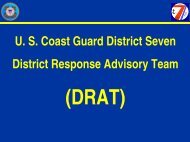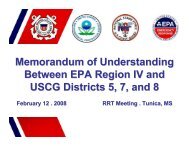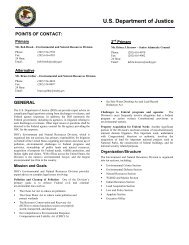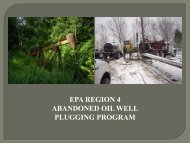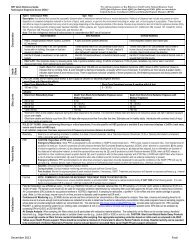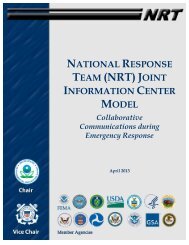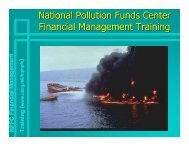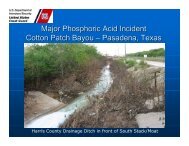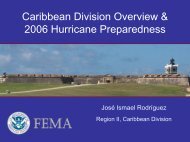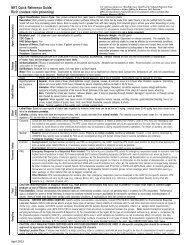USE OF DISPERSANTS - U.S. National Response Team (NRT)
USE OF DISPERSANTS - U.S. National Response Team (NRT)
USE OF DISPERSANTS - U.S. National Response Team (NRT)
- No tags were found...
Create successful ePaper yourself
Turn your PDF publications into a flip-book with our unique Google optimized e-Paper software.
The dispersed oil droplets, ranging in size from microns to a few millimeters, break down by natural processes, suchas biodegradation. Microbial biodegradation of oil appears to be enhanced by dispersal because of the larger surfacearea available as compared to a surface slick. Dispersants also prevent formation of tarballs and oil-in-wateremulsions (mousse), which tend to be resistant to biodegradation due to their low surface area. The chemicaldispersants applied, like the oil droplets, are diluted by diffusion and convective mixing. Much of the solventfraction evaporates immediately after the dispersing is applied. The surfactants are readily biodegraded.Sea TurtlesDescription of Listed Species Presentfor which Assessment was Requested by the U.S. Fish and Wildlife ServiceFour listed sea turtle species occur in the area under consideration. Leatherback, and hawksbill sea turtles areendangered; green and loggerhead sea turtles are threatened. Leatherback sea turtles (Dermochelys coriacea)nesting in the U.S. Caribbean is reported in the Virgin Islands (St. Croix, St. Thomas, St. John) and Puerto Rico,including Islas Culebra, Vieques, and Mona (NMFS and USFWS, 1992). Leatherbacks are considered to be a highlypelagic species but occasionally enter the shallow coastal waters of bays and estuaries. They may concentrate nearand follow drifting schools of jellyfish, their primary prey. Hawksbill sea turtles (Eretmochelys imbricata) arepredominantly tropical. Adult hawksbills characteristically inhabit shallow rocky areas and coral reefs but alsooccur in mangrove-bordered bays, estuaries, and lagoons and occasionally in deep waters. Juveniles occupy thedeeper water pelagic environment, often associated with floating patches of sargassum mats. Hawksbill turtles areomnivorous opportunists and seem to prefer invertebrates, particularly sponges (Ernst et al., 1994). Atlantic greensea turtles (Chelonia mydas) inhabit and nest in the U.S. Virgin Islands and Puerto Rico. Their preferred habitatappears to be lagoons and shoals with an abundance of marine grasses. Adult green sea turtles are primarilyherbivorous, foraging on algae and seagrasses; juveniles may eat a variety of invertebrates as well (NMFS andUSFWS, 1991a). Loggerhead turtles (Caretta caretta) wander widely throughout the marine waters of their range,including the area under consideration. They commonly inhabit the continental shelves and estuarine environments,occurring most frequently in waters less than 50 meters deep (Ernst et al., 1994). Hatchlings and juveniles are oftenfound along current fronts, downswells, or eddies associated with drifting mats of sargassum. Loggerheads areomnivores and feed on a wide variety of benthic invertebrates including crustaceans, mollusks, and sponges (NMFSand USFWS, 1991b).West Indian ManateeThe endangered West Indian manatee (Trichechus manatus), a sirenian, occurs in Puerto Rico and very rarely in theVirgin Islands. Manatees most frequently dwell in protected, low-salinity waters where vegetation is abundant.They are commonly found in the waters of large, slow-moving rivers and river mouths and in shallow, low energycoastal areas such as estuaries or bays. Manatees prefer shallower estuarine and freshwater habitats, rarely venturinginto offshore, open oceanic waters except to move from one favorable feeding area to another. Such movements aregenerally confined to inshore waters less than five meters deep (St. Aubin and Lounsbury, 1990). Seasonalmovements result from the manatee's intolerance to cold. Populations tend to shift south in winter and make shortermovements to and from natural and artificial warm-water refuges such as artesian springs and power-plantdischarges during cold fronts. During the summer, movements are less predictable and the population is moredispersed along the coast as manatees explore alternative feeding areas.Like other sirenians, manatees are aquatic herbivores and feed on a wide variety of submerged, emergent, floating,and shoreline vegetation. In saltwater, they feed primarily on several species of seagrass, including turtle grass(Thalassia testudinum), manatee grass (Syringodium filiforme), and shoal grass (Haladule wrightii). Manatees alsomay eat some species of algae, mangrove leaves, and red mangrove seedlings. They have been known to haulthemselves partially out of the water to consume bank vegetation. In freshwater, manatees feed on a variety ofplants, including Hydrilla verticillata, algae, and water hyacinth (Eichhornia crassipes). Movements andaggregations of manatees, which spend several hours each day feeding, can be correlated with the distribution ofseagrasses and vascular freshwater aquatic vegetation (Reynolds and Odell, 1991).Manatees routinely cross between the islands of Puerto Rico in the area under consideration. As in other areas in the



